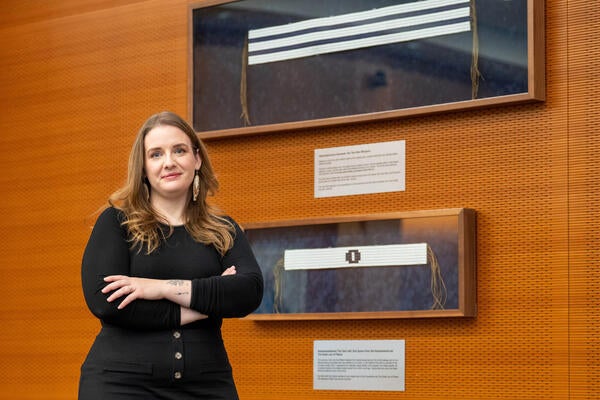
Q and A with the experts: Reclaiming Indigenous histories
Waterloo historian and anthropologist answers questions about the recovery and regeneration of Indigenous artifacts

Waterloo historian and anthropologist answers questions about the recovery and regeneration of Indigenous artifacts
By Media RelationsDuring National Indigenous History Month and as we celebrate National Indigenous Peoples Day on June 21, University of Waterloo historian and anthropologist Talena Atfield answers questions about the recovery and regeneration of Indigenous artifacts, practices and knowledges. Professor Atfield is a member of the Kanien'kehá:ka Nation of the Six Nations of the Grand River.
What do people need to understand about the repatriation and preservation of Indigenous histories and artifacts?
I believe that people should learn how and why Indigenous museum and archival collections were made, the impacts these practices continue to have on communities, and why repatriation can be an important tool for conciliation and healing. Most collections were built on agendas of extermination, land theft, the erasure of Indigenous presence, and literally, on Indigenous physical bodies. The perpetuation of anti-Indigenous sentiments, such as a hierarchical scale of human evolution, in which European settlers were at the top and Indigenous Peoples worldwide occupied various stages below, enabled land theft and resource extraction. This was further supported through pseudoscientific practices that boasted the ability to determine levels of intelligence and moral character through skeletal morphologies, which were used to argue Indigenous peoples had not reached the pinnacle of human evolution.
These ideas were combined with the false notion of the “vanishing race,” which posited that “authentic” or “real” Indigenous people only existed in a “pure” and “uncontaminated” past. Contact with European colonizers resulted in outside influences that doomed “real” Indigenous Peoples to extinction. This, in turn, enabled the widescale extraction of Indigenous material cultures and promoted the erasure of Indigenous presence and contributions to what is now Canada. This extraction en masse saw the removal of items essential to the continuation of some spiritual and ceremonial practices. Many Indigenous individuals and communities are still trying to recover and regenerate knowledges and practices that were affected by these histories.
How is intangible Indigenous knowledges preserved?
Hodinohso:ni people have continued to preserve intangible knowledges through stories, oral histories, and mnemonic devices such as wampum. Stories are a rich source of information, and the act of storytelling and listening to stories has played an integral role in teaching generations of Hodinohso:ni people what it means to be Hodinohso:ni. Intangible knowledges are also preserved in language, Hodinohso:ni languages are rich with information detailing how ideas or objects fit into Hodinohso:ni ethos; much of this information becomes lost in translation, which is why it is so important to support and promote Indigenous language initiatives.
What is the most pressing work yet to be done to preserve and share Indigenous histories?
Making collections accessible to the communities from which they originated would be very impactful. Currently, there are archives full of audio recordings, photographs, and detailed field notes, as well as storage rooms full of material culture, much of which has not been available to the community since it was taken over 100 years ago. Many communities and individuals don’t know how or where to find information related to these collections or how to access them. Items are located all over the world, everywhere but where they are needed most. The most pressing work, in my opinion, is ensuring that institutions have adequate funds and staff to carry out digitization and dissemination of this archival information, as well as decentralizing of the collections back to home communities where possible, so information that has been extracted from communities can be regenerated into practice.
How can people support repatriation, preservation, and knowledge sharing?
I recommend people learn Indigenous histories, on the land they occupy, at the very least. There is incredible diversity within and among Indigenous Nations in what is now Canada. Until recently, Indigenous perspectives and narratives have been entirely absent from the Canadian curriculum. This has played a large role in perpetuating violence against Indigenous peoples. I recommend people attend appropriate cultural events, learn the history of the treaties — or lack thereof — in the areas they live and visit, take courses, and read Indigenous-authored books. There are so many free digital learning opportunities available that uplift Indigenous Peoples' voices from across Canada that people could engage.

Read more
New research from the University of Waterloo centres Haudenosaunee-led efforts in the repatriation and reclamation of cultural and intellectual property

Read more
Researchers awarded funding to investigate ecology, climate change, repatriation, health and well-being through cultural and historical lens

Read more
New Canada Research Chairs will tackle future-focused problems from social robots and intergroup attitudes to geochemistry and nanoscale devices
The University of Waterloo acknowledges that much of our work takes place on the traditional territory of the Neutral, Anishinaabeg, and Haudenosaunee peoples. Our main campus is situated on the Haldimand Tract, the land granted to the Six Nations that includes six miles on each side of the Grand River. Our active work toward reconciliation takes place across our campuses through research, learning, teaching, and community building, and is co-ordinated within the Office of Indigenous Relations.